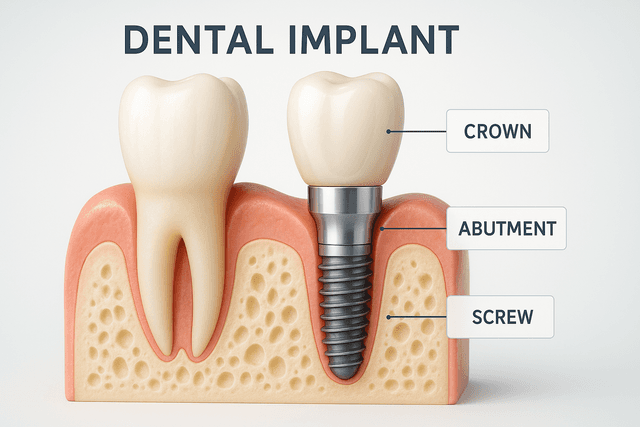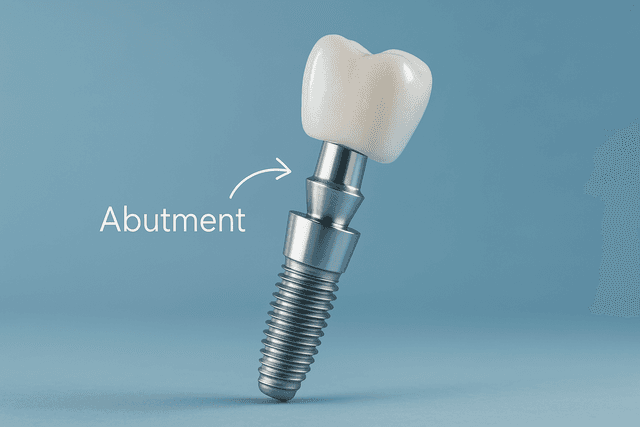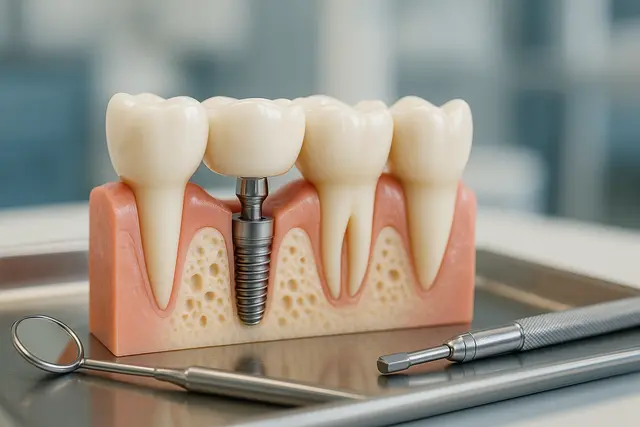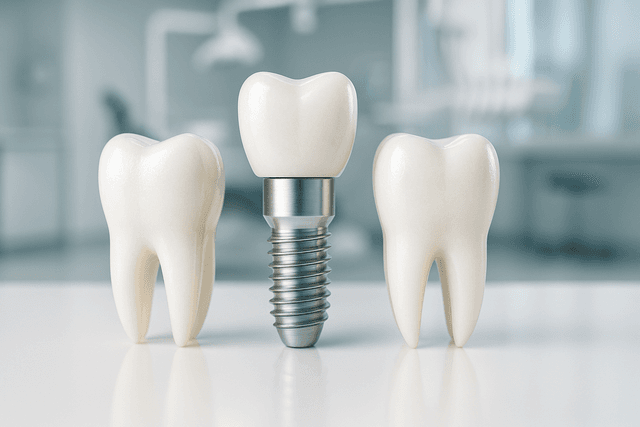Prosthodontics
5 min read
Oct 10, 2025
Implant Abutment Screw Explained: Function, Types, and Placement
Dental implants have revolutionized the way we restore missing teeth, but beyond the visible crown lies a small yet essential component that ensures everything stays firmly in place: the implant abutment screw. Understanding its function, placement, and types is key to appreciating the science and precision behind a successful implant.

If you’re considering a dental implant or you're already somewhere in the middle of the implant process, you've probably heard a lot of unfamiliar terms. One of the most critical, yet often overlooked, parts of the entire implant structure is the tiny but mighty implant abutment screw. It’s not flashy, but this little piece of hardware is the unsung hero that keeps everything together. And today, we're giving it the spotlight it deserves.
Implant Function and Why It’s More Than Just a Tooth Replacement
Let’s start at the top. A dental implant isn’t just one thing. It’s a system. Picture a three-part team:
The implant post (which goes into your jawbone)
The abutment (which connects the post to your crown)
The crown itself (your visible tooth replacement)
Together, they create a lasting solution for missing teeth.
Now, guess who holds this team together? Yep, the implant screw.
This screw connects the abutment to the implant and helps support the implant so your new tooth feels and functions just like the real thing. It's like the glue in your grandma’s famous lasagna, silent but essential.
Abutment Placement and Why Timing Matters
Timing plays a big role when it comes to abutment placement. In some cases, the abutment is placed at the same time as the implant. In others, especially when healing or bone grafting is needed, it happens later.
Your implant dentist will decide based on the condition of your jawbone, the type of implant used, and whether any gum tissue needs to heal first. No two mouths are the same, so customization here is key to implant success.
Screw Design and the Role of Torque in Implant Stability
Here’s where things get technical, but stick with us. The design of the screw and how much torque is used to tighten it impacts everything from implant stability to long-term success.
If the screw is stretched just right when torqued, it stays put and supports the implant restoration beautifully. But if torque is too low or too high? That could lead to screw loosening down the line, which we definitely want to avoid.
Dentists use a torque wrench to get that sweet spot of tension. Most implant manufacturers recommend specific torque levels based on the type of implant and the condition of the jawbone around the implant.
Abutment Types and Choosing the Right Fit
Now onto the type of abutment. There are several, but the two most common are straight and angled abutments.
Straight abutments: our go-to for implants placed directly in line with the missing tooth.
Angled abutments: are used when the implant is at a tilt or the jawbone requires it.
Choosing the right type isn’t just a matter of preference, it’s a strategic decision to ensure the implant and the restoration are properly aligned and stable.
Dental Implant Surgery and What to Expect
Implant surgery usually happens in stages. First, the implant post, typically made of titanium or titanium alloy, is placed in the jawbone. This serves as your new tooth root. Then comes the healing time, which allows osseointegration to happen, that's the process where your bone grows around the implant.
It sounds intense, but don't worry. Your dental professional will walk you through it step by step. Most people report less discomfort than expected and are back to normal within a few days after dental implant procedure.
Osseointegration and Why Patience Pays Off
If there’s one word that sounds fancy but means everything in implant dentistry, it’s osseointegration. It’s the magic that makes a tooth implant feel like it’s part of your body. This process can take a few months, but it’s totally worth the wait.
New bone forms around the titanium post, locking it into place and creating a solid base for the implant restoration to follow. That’s the reason dental implants last so long when done correctly.
Dental Solutions for Long-Term Implant Success
When it comes to tooth replacement, dental implants provide one of the most reliable, natural-looking options available. But success doesn’t just depend on the crown or the visible result. It depends on every part, including that tiny abutment screw.
The entire implant structure needs to work together. If one part fails, say, the screw becomes loose or the implant and abutment don’t fit well, it can lead to implant failure. That’s why dental implant screws play such a vital role in the long-term success of the procedure.
Crown Placement and Final Touches
Once everything is healed, it’s time for the crown to be attached. This is when the implant finally looks like a tooth, not just a post. It also completes the dental restoration process, giving you the confidence to chew, talk, and smile like nothing ever happened.
Sometimes, the crown is screwed in; other times, it’s cemented. Either way, it needs to connect securely to the abutment, which is already attached to the implant. This part of the journey is known as crown placement.
Denture Alternatives and Implant-Based Prosthetics
If you're considering a denture or already have one that doesn’t quite stay in place, dental implants can change the game. Implant-supported dentures snap onto abutments attached to the implant, giving you the feel of natural teeth without the slipping and sliding.
These prosthetic solutions are ideal for people missing several teeth and looking for improved oral health and everyday comfort.
Implant Placement and What Makes It Successful
Implant placement is more than just drilling and inserting. A skilled implant dentist will assess the implant site carefully, often using imaging to decide on the exact angle and depth. In some cases, bone loss from missing teeth requires bone grafting to strengthen the area.
Proper placement ensures that the implant can handle daily forces, chewing, biting, even talking, without shifting or stressing the gum or bone.
Implant Restoration and the Role of Precision
Restoring the dental implant means putting all the pieces together: the implant, the abutment, the crown, and yes, the abutment screw. Every detail matters. The fit needs to be perfect. The torque must be exact. The components, usually made from titanium or titanium nitride, must be compatible with your implant system.
Each implant manufacturer has its own specs, which is why working with an experienced dental professional matters. Precision here directly affects implant success and ensures that the implant lasts for years, if not a lifetime.
What Is an Implant Abutment Screw and Why Is It Important?
An implant abutment screw is the small but essential component that connects the abutment to the dental implant post. It holds the entire implant structure together, supporting the crown and ensuring stability. Without a properly torqued abutment screw, the implant restoration can loosen, shift, or even fail over time. It plays a crucial structural role in both function and longevity of the implant.
When Is the Abutment Placed During the Implant Process?
The timing of abutment placement depends on your specific case. In some treatments, the abutment is placed at the same time as the implant post. In others, especially if healing or bone grafting is needed, it's placed after a healing period. Your dentist will determine the best timing based on bone quality, gum health, and implant system to ensure long-term success.
What Types of Abutments Are Used in Dental Implants?
The two most common types of abutments are straight and angled. Straight abutments are used when the implant is positioned directly beneath the missing tooth. Angled abutments are used when the implant is tilted or when the anatomy of the jaw requires a different approach. Choosing the right abutment ensures proper alignment, bite function, and aesthetic outcomes.
How Does Torque Affect the Stability of an Implant?
Torque refers to the amount of force used to tighten the abutment screw. It must be precisely applied using a torque wrench to ensure the screw stays securely in place. Too little torque can lead to loosening, while too much can cause stress or fracture. Following the implant manufacturer's torque guidelines is essential for long-term implant performance and to prevent complications like screw loosening.
Read Next
Related Posts

Prosthodontics
Implant Abutment Explained: What It Is and Why It Matters
Dental implants have revolutionized the way we restore missing teeth, but there's more to them than just the visible crown. One often-overlooked component, the implant abutment, plays a crucial role in both the function and appearance of the final result. Understanding what it is and why it matters can make all the difference in your implant journey.
4 min read
Oct 10, 2025

Prosthodontics
Pros and Cons of Implant Retained Bridges: A Simple, Honest Overview
Missing teeth can affect more than just your smile, they can impact your confidence, speech, and even how you eat. With so many options out there, it’s easy to feel lost in dental jargon and marketing buzzwords. That’s why we’re breaking down implant retained bridges in plain English, highlighting the pros and cons so you can make an informed choice without the fluff.
6 min read
Oct 10, 2025

Prosthodontics
Implant Crown Lifespan: What to Expect Over Time
Getting a dental implant crown is a big step toward restoring both function and confidence in your smile. But like any dental work, it's natural to wonder how long it will actually hold up. From materials and maintenance to daily habits, several factors play a role in how long your implant crown will last.
4 min read
Oct 10, 2025
Don’t have time to research every dentist around you?
See why 30k+ patients trusted us